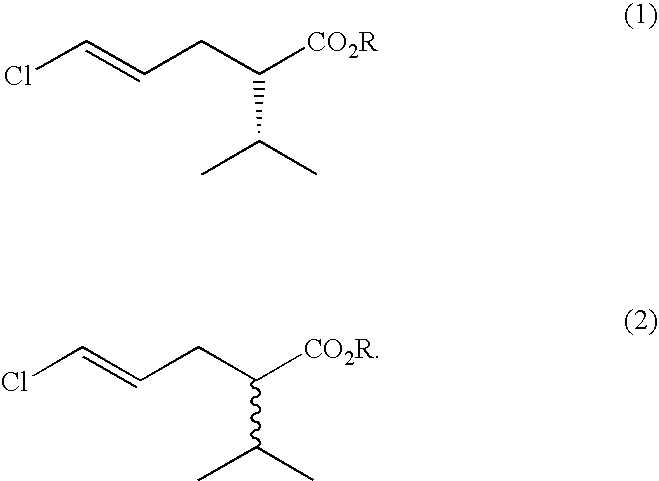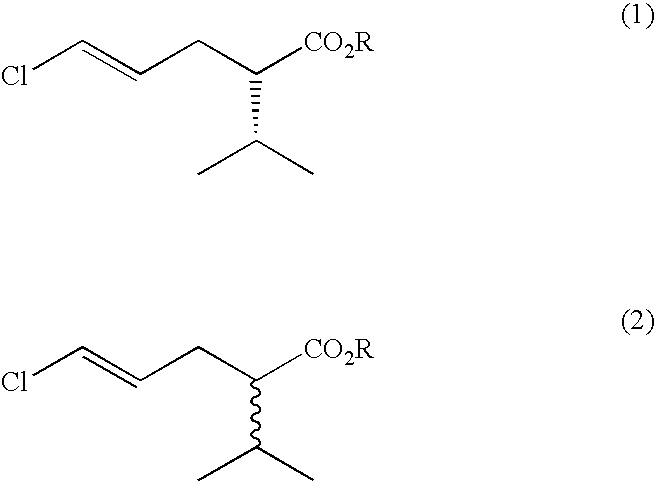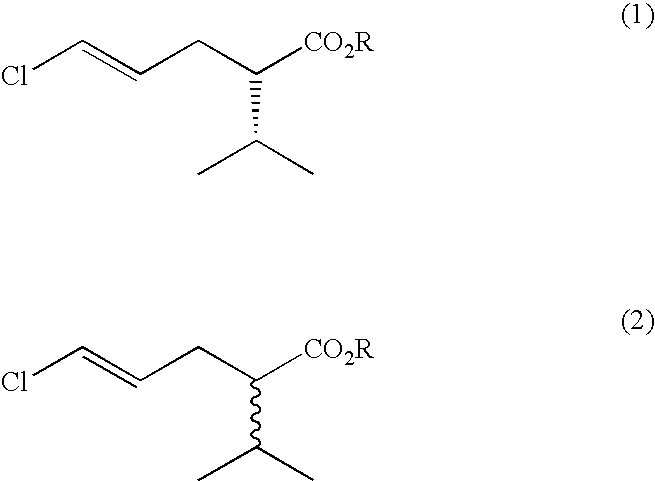Process for the production of (S)-5-chloro-2-isopropylpent-4-enoic acid esters
a technology of pent-4 and pent-2, which is applied in the direction of biochemistry apparatus and processes, fungi-based processes, microorganisms, etc., can solve the problems of unsatisfactory stereoselective synthesis of pent-4enoic acid esters, difficult identification of suitable non-mammalian alternatives to mammalian enzymes, and unattractive commercial use of animal products in the synthesis of pharmaceutical intermediates
- Summary
- Abstract
- Description
- Claims
- Application Information
AI Technical Summary
Benefits of technology
Problems solved by technology
Method used
Image
Examples
example 1
Preparation of Organisms for Screening
[0019]Yeasts were grown in 100 ml of yeast malt extract broth in a 500 ml Erlenmeyer flask for 24-48 h at 25° C. They were harvested by centrifugation prior to resuspension in one-half of the original culture C in volume of 10% glycerol in phosphate buffered saline and stored at −80° C.
example 2
Screening of Biocatalysts (Whole Cells and Isolated Enzymes)
[0020]Initial screening was performed using 5 g / l racemic methyl 5-chloro-2-isopropylpent-4-enoate in 0.1M phosphate buffer pH7+0.1% w / v tween 80. Typically 200 μl was added to the lyophilised cells from 0.5 ml of culture or of 1 mg of enzyme. Reactions were incubated for 2 days prior to dilution in acetonitrile and analysis by gas chromatography using a Chirasil dex CB column. Rhodosporidium toruloides CMC 103105 and Rhodosporidium toruloides CMC103107 were identified as having the desired activity, showing unreacted ester of 7% ee after 7-8% substrate conversion.
example 3
Growth of Yeasts and Confirmation of Activity
[0021]Yeasts were grown from a glycerol stock in 100 mls of yeast malt extract broth contained within a 500 ml Erlenmeyer flask, at 25° C. Cells were harvested by centrifugation at 10,000 g. The pellet from 40 ml of culture was then resuspended in 5 ml phosphate buffered saline. 0.5 ml resuspended cells was added to 0.5 ml 5 g / l Synthon B in 0.1% tween 80 in phosphate buffered saline and incubated at 30° C., overnight. Rhodosporidium toruloides CMC 103105 was confirmed as having the desired activity, with single enantiomer (S)-methyl 5-chloro-2-isopropylpent-4-enoate being obtained after reaction overnight, with an apparent E value of 28. Similar reactions were performed to confirm the activity of the profen esterases described in U.S. Pat. No. 5,912,164. For this purpose, the growth medium for the recombinant E. coli was tryptone soya broth plus additions of isopropyl-beta-D-thiogalactopyranoside and ampicillin.
PUM
| Property | Measurement | Unit |
|---|---|---|
| concentration | aaaaa | aaaaa |
| concentration | aaaaa | aaaaa |
| concentration | aaaaa | aaaaa |
Abstract
Description
Claims
Application Information
 Login to View More
Login to View More - R&D
- Intellectual Property
- Life Sciences
- Materials
- Tech Scout
- Unparalleled Data Quality
- Higher Quality Content
- 60% Fewer Hallucinations
Browse by: Latest US Patents, China's latest patents, Technical Efficacy Thesaurus, Application Domain, Technology Topic, Popular Technical Reports.
© 2025 PatSnap. All rights reserved.Legal|Privacy policy|Modern Slavery Act Transparency Statement|Sitemap|About US| Contact US: help@patsnap.com



